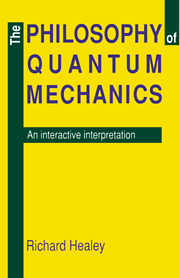3 - Measurement and quantum states
Published online by Cambridge University Press: 05 June 2012
Summary
MEASUREMENT INTERACTIONS
In the present interpretation terms such as ‘measurement,’ ‘observation,’ ‘find,’ ‘classical,’ and ‘apparatus’ do not appear in the formulation of quantum mechanics. Yet it must of course be true that quantum mechanics can be used to predict features of the results of measurements – in particular their statistics. What is required, then, is an account in quantum mechanical terms of those physical interactions capable of being used to perform measurements of quantum dynamical variables, from which it follows that the predicted probabilities for specified behavior of certain quantum systems in these interactions coincide with what, on a more conventional interpretation, are simply postulated as the quantum mechanical probabilities for various measurement results on a system with a given quantum state. It is necessary to see how this consequence may be derived, not only in order to explicate the Born rules, but also to explain the role of quantum states within the present interpretation. The first step toward the required account is to analyze the nature of an interaction capable of being used to perform a measurement of the value of a quantum dynamical variable in a quantum system. Any such interaction will be called an M-type interaction, whether or not it is in fact used to perform a measurement.
The basic characteristic of an M-type interaction is that it establishes a correlation between the initial dynamical state of one quantum system σ (the object system) and the final dynamical state of another quantum system α (the apparatus system).
- Type
- Chapter
- Information
- The Philosophy of Quantum MechanicsAn Interactive Interpretation, pp. 84 - 115Publisher: Cambridge University PressPrint publication year: 1989



